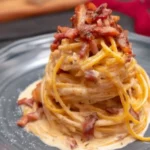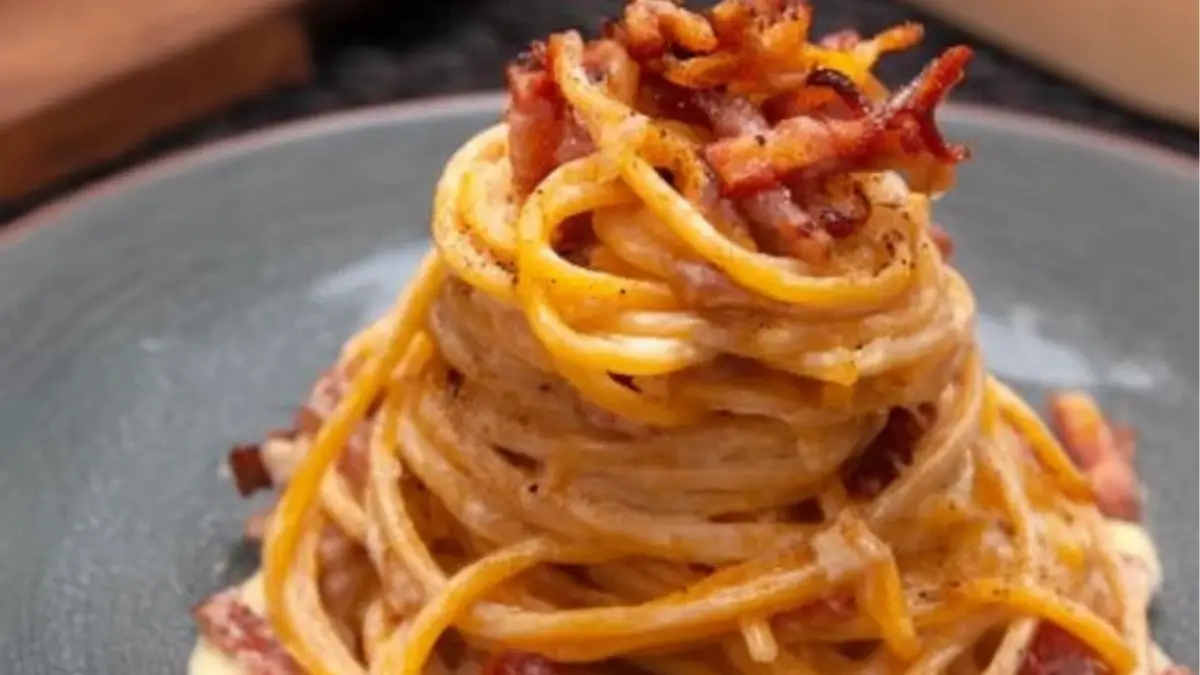It was a rainy Wednesday when I first tried to recreate a dish I’d only ever eaten in the heart of Rome—Pasta alla Gricia. I’d just come back from a trip to Italy, craving that creamy, savory, peppery pasta that had instantly won my heart. As someone still learning the ropes in the kitchen, I wanted to challenge myself without setting myself up for failure. This Roman recipe was the perfect bridge: rustic yet refined, simple yet sophisticated.
Pasta alla Gricia is one of those timeless meals that embodies the elegance of Italian cooking—few ingredients, minimal steps, but maximum flavor. It’s especially perfect for beginner cooks because it doesn’t require any obscure techniques or complicated tools. You can make it in under 30 minutes, and it’s naturally high in protein and calcium thanks to the cheese and pork. If you’re exploring easy sheet pan dinners or searching for more quick and healthy meals, this stovetop stunner is a must-try addition to your weeknight dinner rotation.

Why This Recipe is Special
Pasta alla Gricia is often referred to as the ancestor of Carbonara, with one key difference—it skips the egg but keeps all the richness. Think of it as Cacio e Pepe’s meatier cousin, made even more flavorful with crispy guanciale (or pancetta). Its creamy sauce comes entirely from finely grated pecorino cheese melted into silky pasta water—no cream needed.
This dish shines in its simplicity, which makes it a favorite for weeknight cooking. It also teaches new cooks important skills like making an emulsified sauce, toasting spices, and timing pasta perfectly. In short, Gricia is not just a recipe—it’s a masterclass in mastering Italian technique in your own home kitchen.
Ingredients and Preparation
Spaghetti or Tonnarelli
This is the base of the dish. Choose a sturdy pasta with some chew to it—traditional tonnarelli or basic spaghetti both work well. You want a pasta that grips the sauce.
Guanciale or Pancetta
Guanciale is cured pork cheek, offering a melt-in-your-mouth fat and deep umami flavor. Pancetta, from pork belly, is a great substitute if guanciale isn’t available. For a leaner option, turkey bacon can work in a pinch but will lack the same richness.
Pecorino Romano Cheese
The star of the creamy sauce. This semi-aged sheep’s cheese adds saltiness and a nutty sharpness. Make sure it’s very finely grated for the smoothest sauce.
Freshly Cracked Black Pepper
Adds heat and aroma. Toasting the pepper before use brings out its earthy complexity. Use coarsely ground for better flavor dispersion.
Dry White Wine (Optional)
Used to deglaze the pan and lift all the savory bits from the guanciale. Adds acidity and depth. You can skip it or substitute with a splash of broth if avoiding alcohol.
Hot Pasta Water
Crucial for emulsifying the cheese into a velvety sauce. The starchy water binds everything together and helps adjust texture.
Step-by-Step Instructions
Step 1 Start by toasting freshly cracked black pepper in a dry pan over low heat until fragrant, about 30 seconds. Remove and set aside. This enhances the pepper’s flavor without overwhelming the dish.
Step 2 Slice the guanciale into thick strips and fry in a dry pan over medium-low heat. Cook until the fat becomes translucent, then raise the heat slightly to crisp the outside. The fat should render out and become your cooking oil.
Step 3 Boil water and add your pasta. Cook it until about three-quarters of the way to al dente—don’t worry, it’ll finish cooking in the pan later with the sauce.
Step 4 Once the guanciale is crisped to your liking, deglaze the pan with a splash of white wine. Let it simmer until most of the liquid has evaporated, scraping the bottom to release all the flavor.
Step 5 Add your partially cooked pasta to the pan with the guanciale. Add a ladle of pasta water and stir gently. Sprinkle in the toasted black pepper. Continue cooking until the pasta is fully tender, adding water as needed to prevent sticking.
Step 6 While the pasta finishes, make the cheese paste. In a bowl, mix your finely grated pecorino with a small ladle of hot pasta water, stirring constantly until smooth. This should be a creamy, pourable consistency—not clumpy.
Step 7 Remove the pan from the heat. Immediately stir in the cheese sauce using tongs or a spoon to coat the pasta thoroughly. The residual heat will melt the cheese without making it stringy. Serve immediately.
Beginner Tips and Notes
Avoiding Clumpy Cheese Sauce
Only use finely grated pecorino and always mix it with hot pasta water off the heat. Don’t pour cold cheese directly into the pan.
Guanciale Too Greasy or Crispy?
If the guanciale seems too oily, drain a bit of the rendered fat—but not all! That fat is key for flavor. If it’s over-crisping, reduce the heat or add wine sooner.
Prep Tip
Grate the cheese before you start and keep your pasta water handy in a mug or measuring cup. Timing matters here.
Tool Substitutes
No tongs? A big spoon and fork work. No cheese grater? Use a zester or buy pre-grated—but make sure it’s finely shredded.
Serving Suggestions
Serve your Pasta alla Gricia with a simple arugula salad dressed in lemon and olive oil. Crusty Italian bread is great for mopping up leftover sauce. For a twist, add roasted cherry tomatoes or sautéed spinach on the side for extra nutrition.
Leftover Storage
Store any leftovers in an airtight container in the fridge for up to two days. Reheat gently on the stove with a splash of water to bring back the sauce’s creaminess. Avoid microwaving—it can cause the cheese to separate.
Conclusion
Pasta alla Gricia is a beautiful introduction to the world of Roman cuisine—and a confidence booster for any beginner cook. It proves that with just a few high-quality ingredients and some smart techniques, you can create something truly restaurant-worthy at home. I hope this recipe inspires you to get cooking, and I’d love to hear how your Gricia turned out. Share your tips, tweaks, or proud pasta moments in the comments below!
FAQ About Pasta alla Gricia
Yes, while guanciale provides the most authentic flavor, pancetta is a common substitute and easier to find. In a pinch, thick-cut unsmoked bacon can be used, though the flavor will differ slightly.
Clumps usually form when the cheese is added to the pan while it’s still too hot. To prevent this, always add the cheese paste off the heat and ensure the cheese is finely grated before mixing with hot pasta water.
Parmesan can work in a pinch, but it’s milder and less salty than Pecorino. If using Parmesan, consider adding a bit more salt to balance the flavor.
Reheat gently in a skillet over low heat with a splash of water to loosen the sauce. Avoid microwaving, as it can cause the cheese to separate and the pasta to overcook.
More Relevant Recipes
Print
Creamy Pasta alla Gricia
- Total Time: 25 minutes
- Yield: 4 servings
- Diet: Halal
Description
A creamy and savory Roman pasta classic made with guanciale, pecorino cheese, and black pepper—perfect for beginner cooks seeking a quick and healthy meal.
Ingredients
- 11 oz spaghetti or tonnarelli
- 6 oz guanciale or pancetta
- 6 oz pecorino romano cheese, finely grated
- 1 tbsp black pepper, freshly ground (medium-coarse)
- 1/2 cup dry white wine (optional)
- Hot pasta water (as needed)
Instructions
- Toast the black pepper in a dry pan over low heat until fragrant, about 30 seconds. Set aside.
- Slice guanciale into strips and cook in a dry pan over medium-low heat until fat becomes translucent, then slightly crisp the edges.
- Cook pasta in boiling water for about 75% of the recommended ‘al dente’ time, then drain, reserving the pasta water.
- Deglaze the pan with white wine, stirring to lift browned bits, and let simmer until mostly evaporated.
- Add the partially cooked pasta to the pan with guanciale and some reserved pasta water. Add the toasted black pepper and finish cooking the pasta.
- In a bowl, combine finely grated pecorino cheese with a ladle of hot pasta water, stirring to make a creamy paste.
- Remove the pan from heat, stir in the cheese paste thoroughly, and mix until the sauce is smooth and creamy. Serve immediately.
Notes
- Use pancetta if guanciale is unavailable; avoid smoked bacon for a more authentic taste.
- Finely grate pecorino to prevent clumping—pre-grated cheese may need to be sifted for texture.
- Always add the cheese sauce off the heat to avoid coagulation and clumps.
- For reheating, add a splash of water in a skillet over low heat—avoid microwaving.
- Use less pasta water if you prefer a thicker sauce; more for a looser consistency.
- Prep Time: 15 minutes
- Cook Time: 10 minutes
- Category: Main Course
- Method: Stovetop
- Cuisine: Italian
Nutrition
- Serving Size: 1 plate (approx. 200g)
- Calories: 520
- Sugar: 1g
- Sodium: 580mg
- Fat: 24g
- Saturated Fat: 9g
- Unsaturated Fat: 13g
- Trans Fat: 0g
- Carbohydrates: 54g
- Fiber: 2g
- Protein: 22g
- Cholesterol: 45mg

